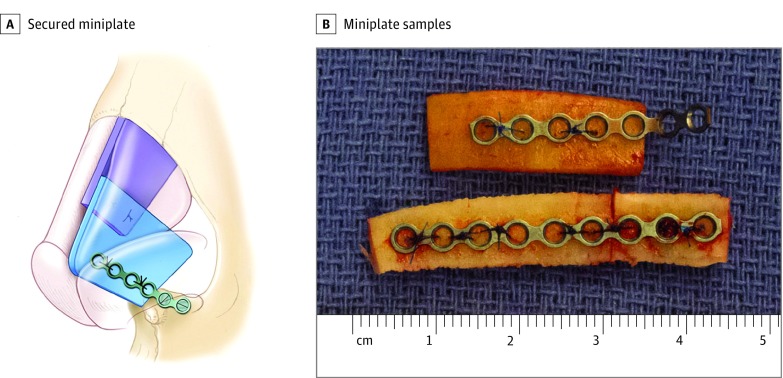Abstract
This case series evaluates the efficacy and safety of titanium miniplates for cartilaginous graft fixation in patients undergoing septorhinoplasty.
Reliable long-term results in septorhinoplasty demand structural stability. This is often achieved with cartilaginous grafts, which may demonstrate warping and movement. Various techniques, including perichondrial stripping and symmetrical shaving, combat warping, but none are reliable. Other techniques involve the use of K-wires for preventing costal cartilage graft warping, absorbable plates for stabilizing septal cartilage grafts, and titanium plates for preventing dorsal onlay graft warping.
A need for rigid fixation arises in the treatment of severe anterocaudal septal deviation. In these cases, one of us (S.M.) has performed modified extracorporeal septoplasty, termed anterior septal reconstruction (ASR), wherein the caudal two-thirds of the septum is removed and a caudal strut is created from cartilage. Traditionally, the ASR graft is secured to the dorsal strut with suture and to the maxilla by splitting the maxillary spine and placing the graft into the split. However, this is not possible when the nasal spine is absent, weak, or displaced. In these situations, titanium miniplates are used routinely by one of us (S.M.).
Miniplates have been used for decades to repair fractures but are infrequently used in septorhinoplasty. We evaluated 3 titanium miniplate fixation functions: prevention of cartilage graft warping, fixation at a cartilage-bone interface, and stabilization of the caudal L-strut. Unlike absorbable plates, these are capable of holding a rigid shape and maintaining fixation for years.
Methods
The 0.4- to 0.5-mm titanium miniplates were used in 3 ways. First, the plates were sutured to the undersurface of dorsally placed rib grafts with permanent suture to prevent warping (Figure). Second, plates secured ASR grafts to the premaxilla using permanent suture to attach the plate to the graft and 1 or 2 self-tapping screws (length, 3-5 mm) to secure the plate to the premaxilla (Figure). Third, plates were used to stabilize the L-strut at the anterior septal angle. Combinations of these methods were also used.
Figure. Stabilization of Anterior Septal Reconstruction (ASR) and Dorsal Onlay Grafts With Titanium Miniplates.
A, Titanium miniplate secured to the ASR graft with permanent suture and to the premaxilla with 1 or 2 screws. The miniplate is secured to the lateral side of an ASR graft and to the undersurface of dorsal onlay graft with 5-0 polypropylene suture. B, Miniplate samples.
The Stanford University institutional review board approved a retrospective review of all patients who underwent septorhinoplasty with titanium miniplates from January 1, 2014, through December 31, 2016, and waived the need for patient informed consent.
Outcomes included nasal stability, graft warping, Nasal Obstruction Symptoms Evaluation (NOSE) scores, and visual analog scale (VAS) scores. Preoperative and postoperative scores were compared with 2-tailed, paired t tests using Microsoft Excel for Mac 2011, with 1-sided statistical significance at the P < .05 level.
Results
This study included 19 patients: 15 underwent secondary rhinoplasty, 1 received cleft lip rhinoplasty, and 3 underwent major nasal reconstruction after cartilaginous atrophy (eg, Wegener granulomatosis). Miniplates were used in 15 patients for the ASR graft, in 6 patients for the dorsal onlay graft, and in 2 patients for stabilizing the anterior septal angle. Autogenous rib cartilage was used in 16 patients, septal cartilage in 2 patients, and homologous rib cartilage in 1 patient. The mean follow-up was 300 days (range, 108-528 days).
One patient had blunt trauma to the nose postoperatively, bending the plate on impact. This was corrected in situ through a hemi-transfixion incision. The remaining patients had no complications.
The NOSE scores indicated good functional outcomes, improving 48 points (possible scores, 0-100; higher scores represent worse obstruction) for those 15 patients with both preoperative and postoperative questionnaires completed (mean [SD] scores: preoperative, 66 [24] vs postoperative, 18 [16]; P < .001). An improvement was also observed in the 13 patients with similarly documented VAS scores (preoperative, 6.4 [2.6] vs postoperative, 1.7 [1.6]; P < .001) (Table).
Table. Nasal Obstruction Symptom Scale and Visual Analog Scale Scores in Patients Undergoing Major Nasal Reconstruction Using Miniplates.
| Scale | Score, Mean (SD) | No. of Patients |
|---|---|---|
| NOSE | ||
| Preoperative | 66 (24) | 15 |
| Postoperative | 18 (16)a | 15 |
| VAS | ||
| Preoperative | 6.4 (2.6) | 13 |
| Postoperative | 1.7 (1.6)a | 13 |
Abbreviations: NOSE, Nasal Obstruction Symptoms Evaluation; VAS, visual analog scale.
P < .001.
Discussion
Titanium miniplate fixation offers a safe and effective technique for cartilaginous graft fixation in septorhinoplasty. To date, no warping, extrusion, or major complications have occurred in these patients. Although the study is limited by midrange follow-up—thus, extrusion could occur in the future—this risk is minimized by covering the plates with durable soft tissue (ie, more than mucosa alone). We believe that miniplates provide safe and stable fixation and support while offering satisfactory aesthetic outcomes.
References
- 1.Sajjadian A, Rubinstein R, Naghshineh N. Current status of grafts and implants in rhinoplasty, I: autologous grafts. Plast Reconstr Surg. 2010;125(2):40e-49e. [DOI] [PubMed] [Google Scholar]
- 2.Boenisch M, Nolst Trenité GJ. Reconstruction of the nasal septum using polydioxanone plate. Arch Facial Plast Surg. 2010;12(1):4-10. [DOI] [PubMed] [Google Scholar]
- 3.Eren F, Öksüz S, Melikoğlu C, Karagöz H, Ülkür E. Saddle-nose deformity repair with microplate-adapted costal cartilage. Aesthetic Plast Surg. 2014;38(4):733-741. [DOI] [PubMed] [Google Scholar]
- 4.Gunter JP, Clark CP, Friedman RM. Internal stabilization of autogenous rib cartilage grafts in rhinoplasty: a barrier to cartilage warping. Plast Reconstr Surg. 1997;100(1):161-169. [DOI] [PubMed] [Google Scholar]
- 5.Most SP. Anterior septal reconstruction: outcomes after a modified extracorporeal septoplasty technique. Arch Facial Plast Surg. 2006;8(3):202-207. [DOI] [PubMed] [Google Scholar]
- 6.Surowitz J, Lee MK, Most SP. Anterior septal reconstruction for treatment of severe caudal septal deviation: clinical severity and outcomes. Otolaryngol Head Neck Surg. 2015;153(1):27-33. [DOI] [PubMed] [Google Scholar]



